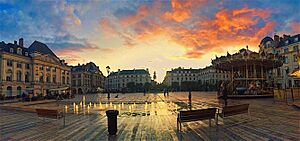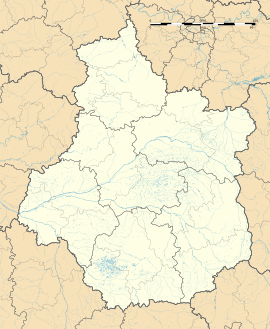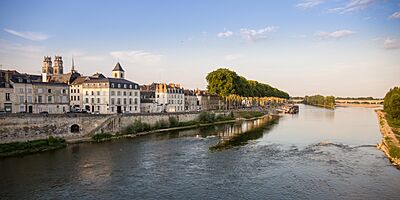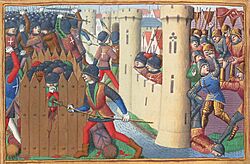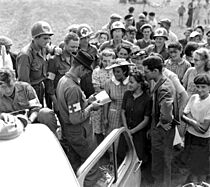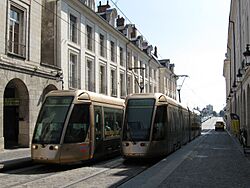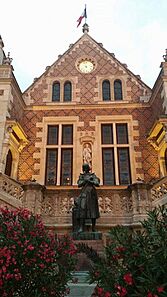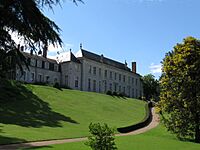Orléans facts for kids
Quick facts for kids
Orléans
|
|||
|---|---|---|---|
|
Prefecture and commune
|
|||
|
Top to bottom, left to right: Rue Jeanne d'Arc and the Sainte-Croix Cathedral, place du Martroi, the equestrian statue of Joan of Arc, bridge George-V
|
|||
|
|||
| Motto(s): | |||
| Country | France | ||
| Region | Centre-Val de Loire | ||
| Department | Loiret | ||
| Arrondissement | Orléans | ||
| Canton | Orléans-1, 2, 3 and 4 and La Ferté-Saint-Aubin | ||
| Intercommunality | Orléans Métropole | ||
| Area
1
|
27.48 km2 (10.61 sq mi) | ||
| • Urban
(2020)
|
289.5 km2 (111.8 sq mi) | ||
| • Metro
(2020)
|
3,422 km2 (1,321 sq mi) | ||
| Population
(2021)
|
116,617 | ||
| • Density | 4,243.7/km2 (10,991.1/sq mi) | ||
| • Urban
(2020)
|
285,926 | ||
| • Urban density | 987.65/km2 (2,558.0/sq mi) | ||
| • Metro
(2020)
|
454,208 | ||
| • Metro density | 132.732/km2 (343.77/sq mi) | ||
| Demonym(s) | Orléanais | ||
| Time zone | UTC+01:00 (CET) | ||
| • Summer (DST) | UTC+02:00 (CEST) | ||
| INSEE/Postal code |
45234 /45000
|
||
| Elevation | 90–124 m (295–407 ft) (avg. 116 m or 381 ft) |
||
| 1 French Land Register data, which excludes lakes, ponds, glaciers > 1 km2 (0.386 sq mi or 247 acres) and river estuaries. | |||
Orléans is a historic city in north-central France. It is located about 120 kilometers (74 miles) southwest of Paris. Orléans is the main city of the Loiret department and the Centre-Val de Loire region.
The city sits on the Loire river, which is part of the beautiful Loire Valley. This area is a World Heritage Site. In 2020, about 117,026 people lived within the city limits. The larger area around Orléans, called the metropolitan area, has about 454,208 people. This makes it the 20th largest metropolitan area in France.
Orléans grew thanks to its location on the river. It was an important trading port. The city was even the capital of France during the Merovingian period. It played a huge role in the Hundred Years' War, especially during the siege of Orléans. This is where Joan of Arc became famous. Every first week of May since 1432, the city celebrates Joan of Arc, also known as the "Maid of Orléans."
One of Europe's oldest universities was founded here in 1306. Today, it is the University of Orléans, with over 20,000 students. Many places in North America, like Île d'Orléans in Canada and New Orleans in the USA, are named after this French city.
Contents
Exploring Orléans: Geography and Climate
Orléans is in a unique spot on the Loire river. The river makes a big bend here, flowing from east to west. The city is part of the Loire Valley, which is a World Heritage Site recognized by UNESCO. To the north of Orléans is the Beauce region and the Forest of Orléans. To the south is the Sologne region.
Five bridges cross the Loire river in Orléans. These include the Pont de l'Europe, Pont du Maréchal Joffre, and the Pont George-V. The Pont George-V is special because it carries the city's tramway.
The northern part of the city, on the right bank of the Loire, is slightly higher. The southern part, on the left bank, is lower and can be a flood-risk area. In the 1960s, a new neighborhood called Orléans-la-Source was built about 12 kilometers (7.5 miles) south of the city center.
Orléans Weather: Climate Overview
Orléans has an oceanic climate, which means it has mild temperatures and rain throughout the year. July is the warmest month, with an average temperature of about 19.7°C (67.5°F). January is the coldest, with an average of 4.4°C (39.9°F).
The highest temperature ever recorded was 41.3°C (106.3°F) in July. The lowest was -19.8°C (-3.6°F) in January. Orléans gets about 635.5 mm (25 inches) of rain each year. It rains fairly evenly, but summer months have fewer rainy days. The city gets about 1,822 hours of sunshine per year, with August being the sunniest month.
The Loire River: A Key to Orléans' Past
The Loire river was once a very important route for trade and travel. In Orléans, a special underwater wall, called a dhuis, separates the river into two parts. This helped keep the river navigable in the past.
Orléans became a major trading center because of the Loire. In the 17th century, it was a big hub for refining sugar brought from the Caribbean. This also helped other local businesses like candy making and paper production. In the 18th century, Orléans became known for its vinegar, made from local vineyards and wine transported on the river.
Today, large ocean ships can only go as far as Nantes on the Loire. The boats used on the river in Orléans were traditionally flat-bottomed with tall, foldable masts. These boats, like the "gabarre" and "futreau," can still be seen by tourists near the Pont Royal.
The river's flow can be unpredictable, which limits boat traffic. However, every two years, Orléans holds the Festival de Loire. This event celebrates the river's important role in the city's history.
Near the city center, on the north bank, is the Canal d'Orléans. This canal used to connect to other canals, helping transport goods. It's not used for its full length anymore, but there are plans to use it for fun activities and even a port for pleasure boats.
Orléans Through Time: A Brief History
Orléans has a long and exciting history, dating back thousands of years.
Ancient Times: From Gaul to Roman City
The area where Orléans now stands was once a stronghold called Cenabum. It belonged to a Gaulish tribe called the Carnutes. This was an important meeting place for their spiritual leaders, the Druids. In 52 BC, the Roman leader Julius Caesar destroyed Cenabum.
Later, in the late 3rd century AD, the Roman Emperor Aurelian rebuilt the city. He renamed it civitas Aurelianorum, meaning "city of Aurelian." Over time, this name changed to Orléans.
In 442 AD, a group of Alans, an Iranian tribe, settled in Orléans. They helped the Romans fight against Attila and his Huns in 451 AD during the Battle of Châlons. The Alans were powerful but sometimes caused trouble with the local people.
Middle Ages: Kings, Wars, and a Famous Heroine
In the early Middle Ages, Orléans became the capital of the Kingdom of Orléans. This happened when Clovis I divided his kingdom. Later, it became a duchy held by the Valois-Orléans family. Some members of this family, like Louis XII and Francis I, even became kings of France.
In 1108, Louis VI of France was crowned in Orléans cathedral. This was rare, as most French kings were crowned in Reims.

Orléans was always a very important city because of its location on the Loire river. It was the northernmost point of the river, making it closest to Paris. There were only a few bridges over the Loire, and Orléans had one of them. This made it one of the richest cities in medieval France.
The city is most famous for the Siege of Orléans in 1429. During the Hundred Years' War, the English tried to capture Orléans. But Joan of Arc, a young French heroine, led the French troops to victory on May 8, 1429. She lifted the siege and became known as "la pucelle d'Orléans" (the Maid of Orléans). The people of Orléans have honored her ever since.
From 1453 to 1900: Recovery and Growth
After the Hundred Years' War, Orléans became prosperous again. The bridge brought in money from tolls and taxes. King Louis XI helped the area by improving farming. The University of Orléans, known for its law studies, also added to the city's fame. Many important people, like John Calvin and Molière, studied there.
In 1560, the French States-General (a kind of parliament) met in Orléans. King Francis II of France died in the city that year. The Orléans Cathedral was rebuilt over many years, starting with Henry IV of France. It shows a mix of late Renaissance and early Louis XIV styles.
When France started colonizing America, the city of New Orleans in Louisiana was named in honor of the Duke of Orléans, who was the regent for King Louis XV. The Dukes of Orléans were very wealthy and powerful, often related to the king.
In 1852, a railway company called Paris-Orléans was created, connecting the city to Paris. During the Franco-Prussian War in 1870, Orléans was again important due to its location. It was occupied by the Prussians for a time.
Modern Orléans: 20th Century to Today
During Second World War, the German army used the Orléans railway station as a major supply hub. The city was heavily bombed by the American Air Force in 1944, causing a lot of damage. Orléans was one of the first French cities to be rebuilt after the war, with work starting in 1945. Some parts were rebuilt exactly as they were, like Rue Royale, while others used new building methods.
Today, Orléans is a medium-sized city with about 250,000 people in its greater area. It continues to use its central location, being less than an hour from Paris, to attract new businesses.
City Symbols: Heraldry and Motto
The coat of arms of Orléans is described as having a red background with three silver "lilies" (which look like hearts or clover leaves). Above this, there's a blue band with three golden fleur de lys. The fleur de lys is a symbol of the French royal family.
The city's motto is "Hoc vernant lilia corde." This Latin phrase means "It is by this heart that lilies flourish" or "This heart makes lilies flourish." This motto was given by Louis XII, who was also a Duke of Orléans.
Population of Orléans
| Historical population | |||||||||||||||||||||||||||||||||||||||||||||||||||||||||||||||||||||||||||||||||||||||||||||||||||||||||||||||||||
|---|---|---|---|---|---|---|---|---|---|---|---|---|---|---|---|---|---|---|---|---|---|---|---|---|---|---|---|---|---|---|---|---|---|---|---|---|---|---|---|---|---|---|---|---|---|---|---|---|---|---|---|---|---|---|---|---|---|---|---|---|---|---|---|---|---|---|---|---|---|---|---|---|---|---|---|---|---|---|---|---|---|---|---|---|---|---|---|---|---|---|---|---|---|---|---|---|---|---|---|---|---|---|---|---|---|---|---|---|---|---|---|---|---|---|---|
|
|
||||||||||||||||||||||||||||||||||||||||||||||||||||||||||||||||||||||||||||||||||||||||||||||||||||||||||||||||||
| Source: EHESS and INSEE (1968-2020) | |||||||||||||||||||||||||||||||||||||||||||||||||||||||||||||||||||||||||||||||||||||||||||||||||||||||||||||||||||
Getting Around: Transport in Orléans
Orléans has a good transport system to help people move around.
Public Transport: Trams and Buses
The TAO company manages the buses and tram lines in Orléans. The first tram line opened in 2000, and a second one in 2012. The tram network is about 29.3 kilometers (18 miles) long. In 2022, over 18 million people used public transport in Orléans.
Roads and Highways
Orléans is a key point for highways in France. The A10 highway connects Paris to Bordeaux and passes near Orléans. The A71 highway starts here and goes towards the Mediterranean Sea. Other important roads include the A19 highway and National Road 20.
Railway Connections
Orléans has two main train stations: the central Gare d'Orléans and the Gare des Aubrais-Orléans in the northern suburbs. Most long-distance trains stop at Les Aubrais-Orléans. From here, you can travel to Paris, Lille, Tours, and many other cities in France.
Famous People from Orléans
Orléans is the birthplace of many interesting people, including:
- Sophie Adriansen (born 1982), a French writer.
- Maxence Boitez, known as Ridsa (born 1990), a singer.
- Marion Cotillard (born 1975), a famous actress, who grew up in Orléans.
- Étienne Dolet (1509–1546), a scholar and printer.
- Isaac Jogues (1607–1646), a Jesuit missionary.
- Charles Péguy (1873–1914), a poet and essayist.
- Florian Thauvin (born 1993), a football (soccer) player.
- Jean Zay (1904–1944), a jurist and politician.
Culture and Landmarks in Orléans
Orléans is rich in history and has many beautiful buildings and places to visit.
Historical Landmarks and Architecture
- The old Gallo-Roman town-wall (4th century AD) can still be seen near the cathedral.
- The Hôtel Groslot was built in the 1550s. King François II died here in 1560. It became the city hall in 1790.
- The Hôtel de la Vieille Intendance (early 15th century) is a beautiful Gothic-Renaissance building. It used to host important visitors and now houses a court. You can see its gardens, which are open to the public.
- The Hôtel de la Motte-Sanguin (18th century) was built for Louis-Philippe, Duke of Orléans. It is now part of a public park.
- The University of Orléans has remains of its 15th-century buildings. It was founded in 1306 and attracted students from all over Europe.
- The House of Louis XI (late 15th century) is on Saint-Aignan square.
- The House of Joan of Arc is a rebuilt version of the house where she stayed during the siege of Orléans. The original was bombed in 1940.
- Place du Martroi is the main square in the city center. It features a large equestrian statue of Joan of Arc.
- The Bannier gate-house, built in the 14th century, was discovered in 1986 under Place du Martroi. You can see it through a window in the underground car park.
- The rue de Bourgogne is Orléans' main street since ancient times. It was the Roman decumanus (east-west street). Many medieval houses can be seen along its sides.
- The Tour Blanche (White Tower) is one of the few remaining medieval defensive towers. It was used during the siege of Orléans.
- The Docks of Orléans were once the most important inland port in France. Wine and sugar from colonies were stored and refined here.
- The Hôpital Madeleine (former hospital) was built in the 18th century by King Louis XIV.
- The Hôtel Cabu (1547) is a beautiful building designed by a famous architect.
- The Hôtel des Créneaux was the former city hall, with a 15th-century bell tower. It now houses the city's music school.
- The Pont de l'Europe is a modern, unique bridge designed by Santiago Calatrava.
- The Pont Royal / George V Royal bridge is the oldest bridge in the city, built between 1751 and 1760. It was renamed after King George V after World War I.
- The Palais épiscopal d'Orléans (former Bishop's Palace) was built in the 17th century. Napoleon stayed there. It now houses a research center for the University of Orléans.
- The Memorial Museum to the Children of Vel d'Hiv remembers over 4,000 Jewish children who were held in camps nearby during World War II before being sent to Auschwitz extermination camp.
- Many other historical houses and mansions can be found throughout the city center.
Museums to Visit
Orléans has several museums where you can learn about art, history, and nature:
- Musée des Beaux-Arts d'Orléans (Fine Arts Museum)
- Charles Peguy Centre
- Joan of Arc's House
- City Historical and Archeological Museum
- Natural Science Museum
Parks and Green Spaces
Orléans has many lovely parks and gardens for relaxation and enjoyment:
- Parc Floral de la Source
- Motte Sanguin garden
- Charpenterie garden
- Botanic garden
- Anjorrant park
- Charbonnière park
- Moins Roux park
- Pasteur park
Media and Communication
- TV network: Orléans TV
- Newspaper: La République du Centre
- Radio station: Radio Campus Orléans 88.3 FM
Music Scene
Orléans hosts an annual week-long classical music festival called Semaines musicales internationales d'Orléans. The city is also home to the band Burning Heads.
Sports in Orléans
Orléans has a strong sports community:
- The city's basketball team, Orléans Loiret Basket, plays in the French first division. They won their first major trophy, the "Coupe de France," in 2010.
- The football (soccer) club, the US Orléans, plays in the Championnat National league.
- There is also a semi-professional rugby team, RC Orléans.
- Orléans is known for its clubs in karate, fencing, and judo.
- In 2012, Orléans was a stage finish for the famous Paris–Nice cycling race.
International Connections: Twin Towns
Orléans is twinned with several cities around the world, promoting cultural exchange and friendship:
 Dundee, United Kingdom
Dundee, United Kingdom Treviso, Italy
Treviso, Italy Münster, Germany
Münster, Germany Kristiansand, Norway
Kristiansand, Norway Wichita, United States
Wichita, United States Tarragona, Spain
Tarragona, Spain Saint-Flour, France
Saint-Flour, France Utsunomiya, Japan
Utsunomiya, Japan Lugoj, Romania
Lugoj, Romania Yangzhou, China
Yangzhou, China New Orleans, United States
New Orleans, United States Kraków, Poland
Kraków, Poland Parakou, Benin
Parakou, Benin
Learning in Orléans: Education
Orléans is a center for education, with several universities and schools:
- University of Orléans: The main campus is in the La Source area.
- Polytech Orléans: An engineering school.
- IUT: University Institutes of Technology.
- IAE: Institute of Business Administration.
- IUP: Professional University Institute.
- ESAD Orléans: School of Art and Design.
- ESCEM: School of Business and Management.
- SUPINFO: Higher education in Computer Science.
- EXIA CESI: School of Industrial Engineering.
Images for kids
See also
 In Spanish: Orleans para niños
In Spanish: Orleans para niños



